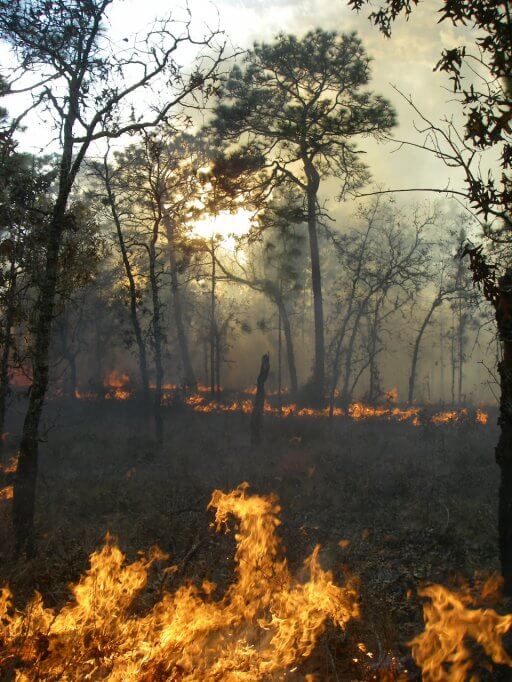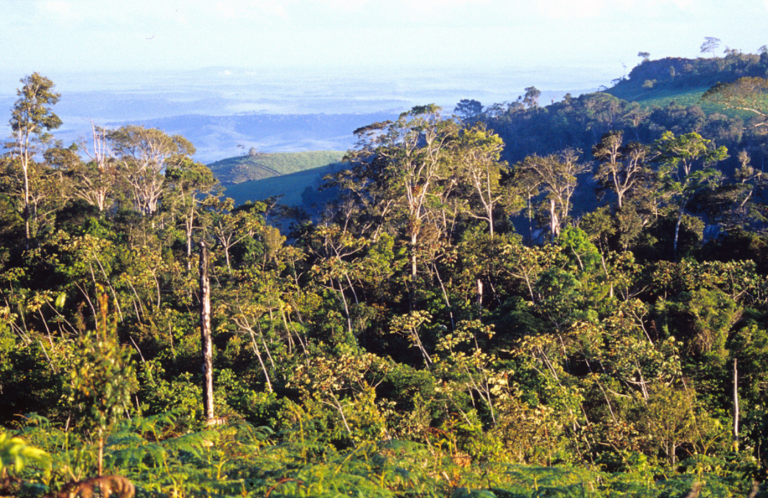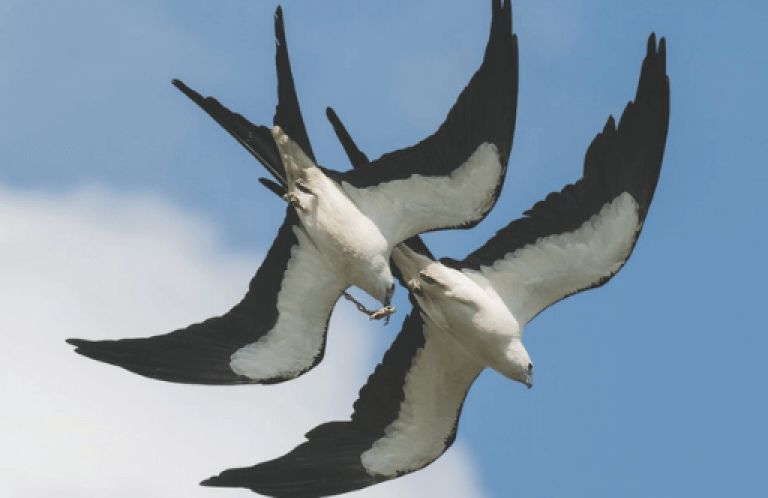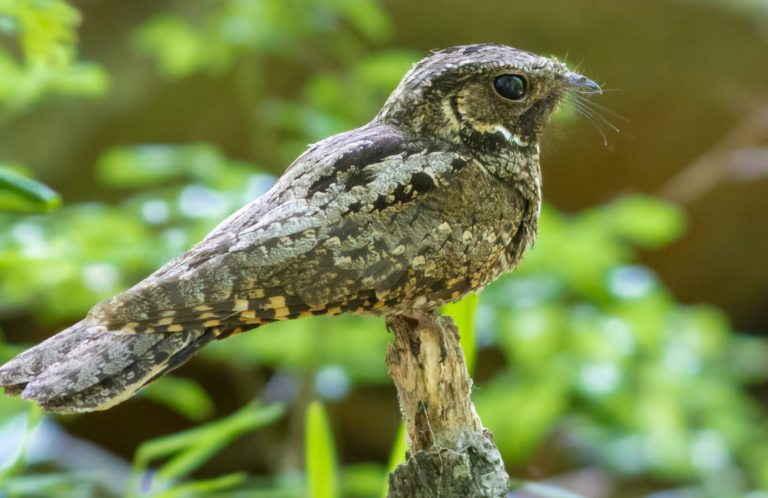Your “Treequently” Asked Questions, Answered Part 2

If you read part one of our Treequently Asked Questions series, you learned about one side of American Bird Conservancy's (ABC) work with trees: tree planting. While ABC has planted a lot of trees (more than 7.7 million to date throughout the Western Hemisphere), we are also engaged in the day-to-day management of forests so that they can meet the needs of birds, other wildlife, and even people.
Some bird species need more than just a forested area: they may need trees of different species and a variety of ages, or forest clearings and edges where shrubby vegetation grows. While some species need a dense, closed canopy, others will thrive with gaps in the canopy that allow light to trickle in or in very open conditions with much more light reaching the ground. Variations in forests occur naturally, but human interventions have eliminated or suppressed many of the processes that create differences in ages, species types, and composition in a forest. A nice, dense stand of trees may look like perfectly suitable bird habitat, but simply increasing canopy cover or planting many of the same tree species doesn't necessarily result in habitat where birds can flourish. Something is missing in forests like this. Although it may seem counterintuitive at first glance, taking away some trees can bring back what's been lost.
Forest management helps achieve this. Members of ABC's team are here to answer some of our most “treequently” asked questions on all things forest management.
Some people have the impression that cutting down trees is universally bad. Why is ABC doing it in some situations? ABC is also planting trees … Doesn't cutting down trees defeat the purpose?
“To keep it simple, we operate on the notion that we want the right trees growing on the right site,” says Tommy Gunn, Oak Ecosystems Forester with ABC, who works throughout the Midwest but concentrates specifically on southeastern Wisconsin and northeastern Illinois.
The forests throughout the region covered by the Appalachian Mountains Joint Venture (AMJV) are largely uniform, with trees of roughly the same size and age. “Historically, the landscape would have been a mosaic of habitats maintained via the intentional management by Indigenous People or natural disturbances,” says Liz Brewer, AMJV Outreach Coordinator. “This mosaic landscape supported a variety of birds and wildlife that need different forest types at different points in their life cycle, like the Golden-winged Warbler.”
The history of unsustainable logging and the suppression of natural disturbances, including fire, has taken a toll on forests. In the absence of disturbance, homogenous forests have grown where diverse forests once stood. This problem plays out in many ways, across many landscapes. As Austin Klais, Conservation Delivery Coordinator for the Lower Mississippi Valley Joint Venture (LMVJV) and West Gulf Coastal Plain/Ouachitas (WGCPO) region notes, “Our region has more trees growing every year than are being harvested. Now, local forestland is often unnaturally dense, leading to declines in local priority bird habitat.”
In the oak forests of the Midwest, “the lack of ‘baby' and ‘teenage' oak trees will have impacts on wildlife if not addressed. The mature trees may be oak-dominated,” says Gunn, but what's underneath them in the dense shade is not. Instead of younger oak trees, tree and shrub species that thrive in shade, typically having less value for wildlife, have grown. Historically, natural fire events would have cleared them out, making way for young oaks to thrive. “Oaks and fire coevolved together. The fire has been removed from the landscape for so long, and we are doing what we can to make up for it.”
The story of the Kirtland's Warbler stands out as a symbol of the relationship between natural fire and trees. This early-successional forest specialist breeds in the Jack Pine forests of Michigan, but only in young Jack Pine. Once a stand has grown too tall, the Kirtland's Warbler will pass it by. Historically, naturally occurring fires would periodically remove these "past their prime" trees, allowing younger trees to grow. But once fires were suppressed because of concerns about human safety and property damage, Kirtland's Warblers began to run out of options.
That is partly how these spritely songbirds ended up on the endangered species list in 1967. A decades-long process of managing Jack Pine habitat, which includes removing trees, has helped them bounce back. “Many bird species depend on vegetation disturbances to create habitat, so it is important to restore or at least replicate those processes through other means,” says Steve Roels, ABC's Kirtland's Warbler Program Director and Conservation Team Coordinator. “Organizations such as the Michigan Department of Natural Resources and U.S. Forest Service clear land for new Kirtland's Warbler habitat. Jack Pine harvesting and replanting is an alternative to fire that creates suitable habitat for the Kirtland's Warbler.”
To have a diverse mosaic of forests across Wisconsin, one-quarter of the state forestlands need to be in a young successional stage, says Jayme Strange, Northern Forests Conservation Delivery Network Coordinator. Strange coordinates partnerships, research initiatives, and on-the-ground efforts to leverage resources for landscape-scale programs that support the strategies of the Upper Mississippi Great Lakes Joint Venture (UMGLJV). “Young forest is important to a wide range of wildlife, including a multitude of migratory and resident bird species. The dense cover in these forests provides protection for nesting, feeding, and brood rearing, and young vegetation offers seeds, berries, and nuts and attracts insects.” Maintaining forests in that stage can't always happen on its own, Strange says. ”In some cases, the only way to restore a young successional forest is to cut some trees.”
“It's all a balancing act. We need to both cut and plant trees to consider forest management holistically,” says Michael Paling, ABC's Michigan Forester. Paling works with private landowners to manage their property for Golden-winged and Kirtland's Warblers. “If we cut down a forest of aspen trees, we can have tens of thousands of new aspen stems growing back. This dense, thick forest is perfect for birds like the Golden-winged Warbler, Brown Thrasher, Chestnut-sided Warbler, and many more species. Additionally, planting new trees, such as oaks, can help us provide new food sources for wildlife in an area that doesn't already have that resource.”
“Planting trees and cutting trees are not antithetical,” says Brewer. “They are both important tools that can help improve habitat for the birds we're working to conserve.”
Who decides when to cut trees and which ones get cut? Do you prioritize cutting non-native species?
Forest management plans change from place to place, but removing non-native and invasive species is often the first step in any management strategy. Deciding to cut down a tree is a collaborative endeavor guided by science. At the end of the day, though, in sustainable forest management, “the trees themselves make the decision,” as Paling puts it. “Foresters look at stocking levels (density) of trees in the forest (among the overstory, midstory, and understory). We look at plant species diversity, soil conditions, forest health issues, and invasive species.”
What gets cut depends on the objectives for the land, site conditions, and resource concerns being addressed on site, says Klais. Public and private landowners look to foresters, biologists, loggers, conservationists, and silviculturists to help guide their forest management plans and meet their goals for the land. Local and federal regulations also play a role in the timing of a cut, and the number and types of trees that will be removed.
What happens to trees after they have been cut?
Trees harvested under a sustainable forestry plan typically have a second life, either in situ or becoming timber, firewood, or valuable products from printer paper to the paper fiber found in diapers, and from wood flooring to whiskey barrels.
“Some trees are left on site to become habitat features and will eventually contribute to the slow process of building the soil in the forest,” Gunn says. A dead tree can be left standing, providing nesting habitat for woodpeckers. When the tree eventually falls over, turtles or salamanders might move in. “As the years go by, natural decay processes break the tree down until it becomes part of the forest floor.” Parts of trees are sometimes left behind to provide shelter for wildlife and a buffer from browsing deer.
Some trees live on in a different way: “Aspen trees will grow back from root suckers and you can grow a forest that's 100 percent genetically similar. Oaks, spruces, pines, and many other trees will grow back from seeds they've dropped on the forest floor but haven't had enough sunlight to sprout until the older trees are harvested,” Paling says.
Does ABC ever clearcut an entire area? Why?
Sometimes, an area needs more help getting back to its natural “baseline.” This can be due to unhealthy trees, trees that would have naturally been removed by fire or other processes but have instead remained standing, or non-native trees that are not benefiting wildlife. The land might need to be given a clean slate through a practice called clearcutting. This, Paling notes, is “a scientifically proven silvicultural practice used for a specific objective, such as ‘coppice cutting' in aspen or red maple stands where trees are removed specifically to stimulate stumps and roots to regenerate the forest, while still utilizing the timber. The forest becomes young again, but it's still a forest, one that is beneficial for Ruffed Grouse, Golden-winged Warblers, and other wildlife.”
This technique is employed with the future health of the forest in mind. It provides a fresh start for healthy, native trees to grow. That is the fundamental difference between clearcutting and what it is commonly mistaken for: deforestation. Deforestation involves changing the land use of a forested area in its entirety. Trees may be burned or cut down and stumps dug up to convert an area for use by people, often for agriculture or development.
ABC's foresters will recommend giving a forest a fresh start when it is appropriate, says Gunn, who notes, “the majority of the forested landscapes across the eastern U.S. are older mature trees that do not have the patchwork of young regenerating forest interspersed with older forests that we would have with widespread natural processes such as fire.” Cutting trees is one technique for creating that ‘patchwork' effect. “In Appalachia, part of a forest management plan might be a ‘patch cut.' This will be done near a more mature forest to restore that mosaic of habitat types that birds need throughout their life cycle,” Brewer with the AMJV adds.
Clearcutting has been put to use in Kirtland's Warbler breeding habitat to clear large tracts of older Jack Pine to make way for younger trees. “Most breeding habitat has very few trees other than Jack Pine, but occasionally large oaks are retained. Large snags (dead trees) are also sometimes spared because male Kirtland's Warblers like to use them as singing perches to let their voice ring out over the tops of the Jack Pine,” Roels says.
Does ABC ever cut down a tree it has planted? Why?
If it aligns with the site's conservation plan and the landowner's objectives, a tree ABC has planted may be cut down, but that is not the norm. When a landowner seeks to generate revenue while managing their land for conservation, trees are sometimes planted at a rate that produces higher timber values and may grow large enough to require thinning, which would benefit the landowner, wildlife, and overall forest health. But, in general, it is unlikely that an ABC-planted tree will be cut down — at least not for a few decades.
“In Kirtland's Warbler Management Areas, Jack Pine are typically cut 30-50 years after planting,” says Roels. “Decades from now, we will support the cutting of the very trees we supported planting! Whether through fire or timber harvest, the entire Jack Pine ecosystem depends on cycles of renewal to sustain the plants and animals that live there.”
ABC itself is only 30 years old, so a day will come when some of our trees will need to be cut to maintain the best conditions for birds and preserve the health of the forest. That isn't a regular occurrence now. That could change, however, if the science warrants it: “Keep in mind, we base our recommendations on the best available science. Sometimes we learn new things that may change our management plans. Forests are complex systems, and we are doing our best to make them better,” says Gunn.
How are local communities, landowners, nonprofits, and other parties involved in timber harvesting or forest management? Who benefits?
“I see a huge variety of local communities, landowners, and nonprofits working together on different timber harvests or forest management,” says Strange. “In general, everyone benefits in some way. In the northern states of Minnesota, Wisconsin, and Michigan, forest management is a large economy for local communities.”
Paling echoes this sentiment: Forest management is a huge industry. “It includes private landowners, state natural resources departments, the U.S. Forest Service, local conservation districts, land conservancies, logging companies, timber investment management organizations (TIMO), nonprofits, and more, and they all interact.”
In an ideal scenario, timber harvesting can support other conservation work on the same land. Gunn lays out what that situation might look like: “A landowner may decide to harvest some trees based on their goals for the property and the recommendations of a forester. The sale of trees generates revenue for the landowner while contributing to the conservation goals of the property by funding noncommercial management such as ongoing invasive species control.” Along the way, those trees are part of a local economy involving foresters, loggers, truck drivers, employees at the sawmill, invasive species contractors, as well as funds spent in the community.
There are positive outcomes that go far beyond the revenue generated and the habitat maintained through timber harvesting.
“In Appalachia, much of our work is with private landowners who are active in providing input on the forest management happening on their land,” Brewer says. “There is also increasing interest in the region in forest farming, growing native edible plants and mushrooms in the forests, many of which benefit from the sustainable forestry practices our partners use. A healthy forest can provide recreation opportunities, forest farming and foraging opportunities, improved watershed health, and habitat to support wildlife and birds.”
How does prescribed fire fit into ABC's work?

Prescribed fire, sometimes called a “controlled burn,” is one technique used to improve habitat conditions in some circumstances. Fire was once a natural part of many ecosystems and a management technique successfully harnessed by some Indigenous Peoples. “For many millennia, Native Americans used cultural burning to promote healthy vegetation and habitat for animals that provide food, clothing, ceremonial items, and more,” says Strange. “Fire has been suppressed by development, so prescribed fire has become a safe alternative to restore forest health. Many of our forests used to rely on frequent, low-intensity fires to manage forest diversity naturally.”
In Michigan, prescribed fire is currently used to create only a small percentage of Kirtland's Warbler habitat. Used more widely in areas safely distanced from homes and businesses, prescribed fire could be a cost-effective habitat management technique. It could bring other benefits, too: “Fire cycles nutrients and affects the soil in ways that are difficult to replicate with timber harvests,” Roels says.
Like the Jack Pines in Michigan that host breeding Kirtland's Warblers, “Southern pine evolved in a fire-adapted environment” as well, says Bill Bartush, Lower Mississippi Valley Joint Venture Partnership Coordinator. “Many species like Longleaf Pine require frequent fire to thrive. We promote 2-5 year fire return intervals.”
In the right settings, prescribed fire can be carried out safely and bring a host of benefits to the land. “We desperately need more prescribed fire on our landscape. I encourage landowners I work with to use this technique if possible,” Gunn says.
What techniques are used for timber harvesting or forest management?
“Silviculture is the overall ‘art and science' of forest management,” says Paling. It encompasses all management techniques such as timber harvesting, tree planting, thinning stands of trees, and more, and it often takes a combination of them to manage a forest well. Strange says, “Using multiple timber harvesting or forest management techniques is the best way to achieve a healthy forest system that provides breeding, protection, and foraging for birds. A mosaic of age classes across the landscape provides healthy habitat for local wildlife.”
The techniques employed for managing tree density and habitat conditions depend on the forest and the goals of landowners and conservationists for the property and fall under three categories: mechanical (commercial, mulching, chainsaws), chemical (in certain circumstances, herbicides may be used broadly or selectively and matched to the need on the landscape), or prescribed fire. Foresters also manage forests for invasive species and maintain forest health by adjusting species composition, the structure of a forest stand, and the number of trees by removing trees.
How has over-harvesting harmed the reputation and public perception of responsible forestry? Is the forestry industry more sustainably run now, or is it just bird-friendly sites?
“Forest management today is nothing like it was 100-plus years ago,” Paling says. “During the 1800s, everything was clearcut regardless of the forest type.” That approach has made a long-lasting impression on the public.
“Over-harvesting has led to the perception that it's better to not manage forests at all, and the misconception that forests were ‘untouched' before European settlers arrived — but that's not true! Forests were managed by Indigenous People in North America long before settlers arrived,” says Brewer.
Timber harvesting has changed from the days when land was permanently cleared. “Now, every decision starts with the forest type, which dictates what kind of harvesting can occur,” Paling continues. As in any industry, Gunn says, there are bad actors and good actors, but forestry has evolved. It is much less extractive and far more holistic. By and large, foresters are concerned with the health of the forests in their care and the role a healthy forest plays in supporting entire ecosystems.
“If we are sick, we go to the doctor. When our forests need help, we employ foresters,” says Gunn.
Today, many foresters keep conservation in mind in their work. The Sustainable Forest Initiative (SFI) conservation certification is “an outstanding model,” says Bartush. Companies like International Paper, a partner in ABC's work to conserve habitat for Swallow-tailed Kites in the Southeast U.S., that use SFI-certified timber are helping to initiate a seachange among landowners. “Those who align with the SFI conservation plans are managing forests very well,” Bartush continues.
How do sustainable forestry processes draw from Traditional Ecological Knowledge (TEK)? What can we learn from the fact that prior to industrialization humans have been sustainably using trees for thousands of years?
Traditional Ecological Knowledge is paramount in how we approach land management, Strange says. TEK can inform, guide, and complement the work of foresters. In the Great Lakes region, Strange notes, “We lean heavily on the Great Lakes Indian Fish and Wildlife Commission (GLIFWC) to provide natural resource management expertise that follows TEK.” Bartush shares that the Alabama-Coushatta Tribe of Texas has a long history steeped in the Longleaf Pine forests and prescribed fire. Indigenous Peoples can hold irreplaceable knowledge about the land they inhabit and how to live on it, but those long-standing practices, like prescribed fire, have been deliberately suppressed.
Limiting forest fires helped prevent the destruction of homes, businesses, and property as more areas became more inhabited, but the loss of fire came with drawbacks. “We're starting to realize the negative impacts of removing fire from the landscape and there are efforts in Michigan to encourage more use of prescribed fire,” Paling says.
A great deal has been lost in the absence of prescribed fires, both in terms of Indigenous lifeways and forest diversity and resilience. Roels explains, “Planned burns created open, high-productivity areas for better hunting and reduced the chances of much larger fires that would place villages and encampments at risk. The heterogeneity created on the landscape by Indigenous fire helped maintain regional biodiversity and allowed Indigenous Peoples easy access to natural resources. For example, wild blueberries thrive in the years following a fire and can be a significant dietary component for both people and Kirtland's Warblers!”
We'll Take Our Leave…
Our “Treequently” Asked Questions series has only scratched the surface of ABC's work throughout the Western Hemisphere to restore, create, and maintain forestlands that provide the resources birds need to thrive. As ABC's team has shown, forests are diverse and the approaches for managing them are, too. Foresters have a suite of techniques at their disposal — some newly developed and driven by advances in science, others time-honored practices from Indigenous Peoples who have stewarded the land — for encouraging and improving the health of forests. Forestry has come a long way from the days of indiscriminate clearcutting. Today's foresters are conservationists, Brewer says. “We love forests and we want to have healthy, sustainable forests for years to come!”
There is no “one-size-fits-all” approach to managing forests. Maintaining or improving a forest doesn't have to mean closing it off from human use entirely. Bartush says that foresters can “provide land managers choices to continue to develop working forestlands for income — as well as promote habitat for many wildlife species.”
Managing a forest for birds means “much more than simply increasing tree cover on the landscape,” Roels says. “Different ages of forest support different wildlife species; some species even use multiple forest ages during their annual cycle. In order to effectively conserve all forest species, we need to restore ecological processes, which include disturbances that return parts of the forest to younger ages.” Employing techniques like prescribed fire and cutting trees is in some cases necessary to conserve the habitat most valuable for declining and threatened species, says Klais.
From planting trees to cutting patches so young trees can thrive, ABC's work with forests always keeps the needs of birds and people in mind. Making more space for birds by creating, connecting, and improving habitat is one of the most powerful tools at our disposal for reversing species declines and protecting vulnerable species.
You can support ABC's work to improve forest habitats throughout the Western Hemisphere. Watch our webinars to learn more about the forestry work of ABC and our partners in the Great Lakes and the Southeast.


















































